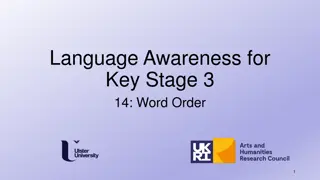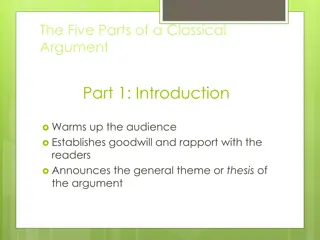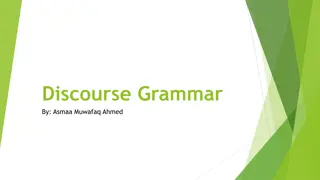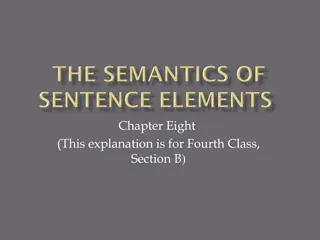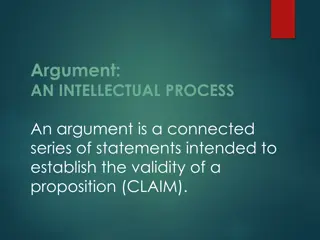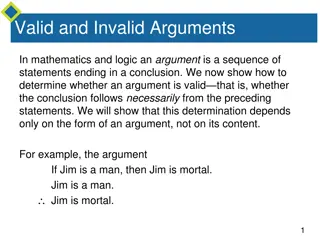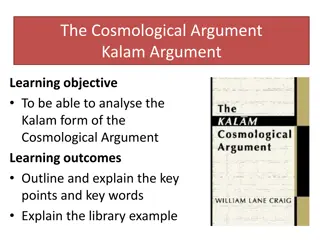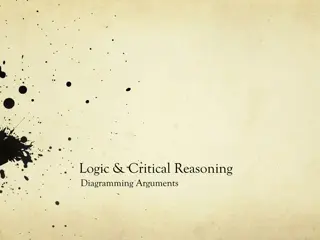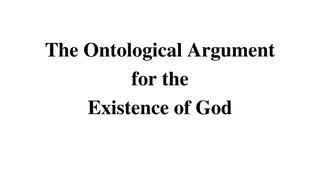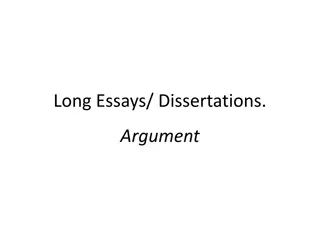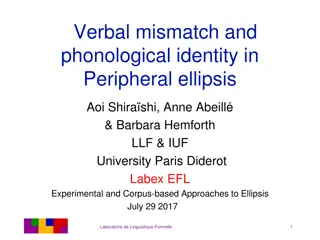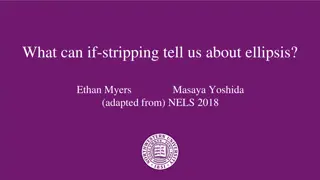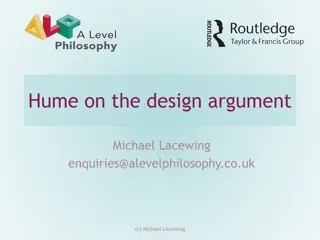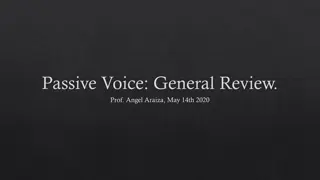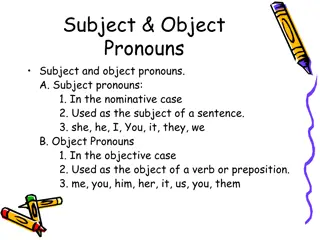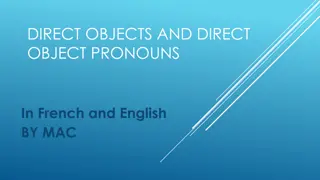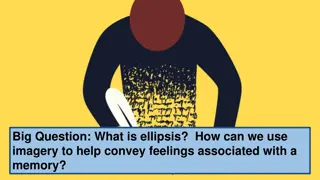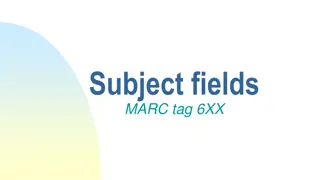Subject-Object Asymmetries in Zazaki Argument Ellipsis
Many languages allow argument ellipsis (AE), where an argument can be omitted for sloppy or quantificational interpretations. Subject-object asymmetries arise in languages due to subject-verb agreement. This study presents evidence from Zazaki, a Northwestern Iranian language, challenging the anti-agreement theory of AE. Zazaki's split-ergative agreement pattern contradicts the predicted possibilities of AE, making it essential to reconsider current linguistic theories.
Download Presentation

Please find below an Image/Link to download the presentation.
The content on the website is provided AS IS for your information and personal use only. It may not be sold, licensed, or shared on other websites without obtaining consent from the author.If you encounter any issues during the download, it is possible that the publisher has removed the file from their server.
You are allowed to download the files provided on this website for personal or commercial use, subject to the condition that they are used lawfully. All files are the property of their respective owners.
The content on the website is provided AS IS for your information and personal use only. It may not be sold, licensed, or shared on other websites without obtaining consent from the author.
E N D
Presentation Transcript
Subject-object asymmetries in Zazaki Argument Ellipsis: A problem for the anti-agreement theory RYAN WALTER SMITH UNIVERSITY OF ARIZONA 1STNORTH AMERICAN CONFERENCE ON IRANIAN LINGUISTICS 04/29/2017
Introduction Many languages permit argument ellipsis (AE). An argument may be null, permitting sloppy or quantificational interpretations not attested with overt pronouns. In some languages (Persian), sloppy/quantificational readings are not possible in subject position. One explanation of this is that the absence of agreement in a language permits AE in the first place (Saito 2007), and that subject/object asymmetries arise due to subject-verb agreement (Sener & Takahashi 2010; Sato & Karimi 2016).
Goal of the talk I provide evidence from Zazaki (Northwestern Iranian) against Saito s anti-agreement theory of AE. Due to the split-ergative agreement pattern of Zazaki, the anti- agreement theory predicts that AE should be possible with subjects in the past tense, and with objects in the present. This is not the case: Zazaki permits object AE, and disallows subject AE, regardless of which argument is agreed with.
Overview Introduce argument ellipsis and subject/object asymmetries therein. 2. Discuss the anti-agreement theory and its merits. 3. Introduce Zazaki AE and the problem it poses for the anti-agreement idea. 4. Discuss problems for other approaches 5. Conclude with some possible alternatives. 1.
Argument Ellipsis Many languages exhibit argument ellipsis (AE): arguments may be left unpronounced, leading to the possibility of the types of strict/sloppy ambiguities observed in cases of ellipsis. These contrast with the use of an overt pronoun, which, in most circumstances only permit strict readings. Extensively studied in the context of East Asian languages like Mandarin (Huang 1991) and Japanese (Hoji 1998; Tomioka 2003; akahashi 2008;).
Strict/Sloppy ambiguities in Japanese (1) Taroo-wa jibun-no sensei-o mita Taroo-Top self-Gen room-Acc saw Taro saw his teacher (2) Hanako-mo __ mita Hanako-also saw Hanako also saw (her own or Taro s teacher) (3) Hanako-mo Hanako-also he-Acc Hanako also saw him (only Taro s teacher) kare-o mita saw
Strict/Sloppy cont. These are attested in the subject position in Japanese as well. (4) Taroo-wa jibun-no teian omotteiru Taroo-Top self-Gen proposal-Nom accept do-pass-prs C think-prs Taro thinks his proposal will be accepted -ga saiyoo sareru to (5) Hanako-mo __ saiyoo sareru Hanako-also accept do-pass-prs C think-prs Hanako also thinks (Taro s/her own proposal) will be accepted to omotteiru (6) Hanako-mo sore-ga Hanako-also that-Nom accept do-pass-prs C think-prs Hanako also thinks it will be accepted (only Taro s proposal) saiyoo sareru to omotteiru
Sloppy readings of null objects in Persian Persian also permits argument ellipsis, showing the same sloppy/strict ambiguity (Sato & Karimi 2016). (7) Bah r mo allem-esh-o dust d r-e Bah r teacher-3.Sg-R friend have-3.Sg Bahar likes her teacher (8) Mohsen ham _ dust d r-e Mohsen also friend have-3.Sg Mohsen also likes (his own/Bah r s teacher) (9) Mohsen ham un-o dust d r-e Mohsen also 3.Sg-R friend have-3.Sg Mohsen also likes him/her (only Bah r s teacher)
The subject/object asymmetry in Persian AE Unlike Japanese, however, sloppy readings are not generally possible in subject position. A similar restriction is found in Turkish (Sener & Takahashi 2010). (10) Bah r goft ke Bahar said that friend-Pl-3.Sg come-3.Pl Bahar said that her friends are coming dust-h -sh miy n (11) Mohsen goft ke __ ne-miy -n Mohsen said that Neg-come-3.Pl Mohsen said they re not coming (only Bah r s friends) (12) Mohsen goft ke un Mohsen said that 3.Pl Neg-come-3.Pl Mohsen said they re not coming (only Bah r s friends) ne-miy -n
Interim Recap and a Question Japanese and Persian both permit AE. They differ in that while Japanese permits AE in subject and object position, Persian (as well as Turkish) does not permit it in subject position Why should this be?
Enter the anti-agreement theory Saito (2007) proposes the anti-agreement theory of AE: (13) The anti-agreement theory of argument ellipsis A language will allow argument ellipsis if it lacks phi-agreement with its arguments. Languages like Japanese and Korean lack agreement, and thus allow AE. Languages like English possess subject-verb agreement (as well as agreement between v and the object to assign accusative Case), and thus lack AE entirely.
Anti-agreement: a success for Persian? Languages like Persian (and Turkish) possess subject- verb agreement. As such, the anti-agreement theory correctly predicts that AE will be unavailable in the subject position of these languages, while permitting it in object position. As such, Sener & Takahashi (2010) and Sato & Karimi (2016) have argued that the anti-agreement theory receives support from Turkish and Persian, respectively But what if we expand the empirical domain a bit?
Enter Zazaki Zazaki is a Northwestern Iranian language, spoken primarily in eastern Turkey. Zazaki permits AE: null objects are ambiguous between a strict and sloppy reading. (14) Muhsin mal m- Muhsin teacher-ez.3.sg.m self Muhsin sees his teacher xo v nen-o see-3.sg.m (15) R za ki R za also see-3.sg.m R za also sees (strict/sloppy) R za also sees him (strict only) v nen-o (16) R za ki R za also 3.sg.m.obl see-3.sg.m ey v nen-o
Zazaki: Like Persian after all? Like Persian and Turkish, Zazaki exhibits a subject/object asymmetry: subjects do not permit sloppy readings. (17)Muhs n-i vat ke Muhsin-obl.sg.m said that friend-ez.sg.m self room.f do-3.sg.m clean.m Muhsin said that his friend cleans the room dost- xo oda ken-o pak (18) R za-y R za-obl.sg.m R za said that cleans the bathroom vat ke said that bathroom-obl.sg.m banyo-y k-en-o pak do.3.sg.m clean (only Muhsin s friend) (19) R za-y vat ke R za-obl.sg.m said that 3.sg.m.dir bathroom-obl.sg.m do-3.sg.m clean R za said that he cleans the bathroom (only Muhsin s friend) o banyo-y ken-o pak At first glance, this seems to offer further support for the anti-agreement theory.
Zazaki split-ergativity and a prediction Zazaki is split-ergative. In the present, the verb agrees with the subject, but in the past, it agrees with the object. The anti-agreement theory makes a prediction here: in the past tense, the subject/object asymmetry should be the reverse of the one in the present tense. We should expect the object to fail to possess sloppy readings in the past, while the subject should permit such sloppy readings.
A failed prediction This is not borne out! Null objects continue to possess sloppy interpretations in the past tense, while null subjects are unambiguous. (20) Muhsin-i Muhsin-obl.sg.m friend-ez.3.pl self saw-3.pl Muhsin saw his friends yesterday dost- xo di-y (21) R za-y R za-obl.sg.m R za also saw (his own or Muhsin s friends) ki di-y also saw-3.pl
A failed prediction, cont. Subjects are unambiguous despite lack of agreement (22) Muhsin-i vat ke Muhsin-obl.sg.m said that friend-ez.sg.m self room.f did-3.sg.f. clean-sg.f Muhsin said that his friend cleaned the room dost- xo oda kerd-e pak-e (23) R za-y R za-obl.sg.m R za said that cleans the bathroom (only Muhsin s friend) vat ke said that bathroom did.3.sg.m clean.sg.m banyo kerd pak The anti-agreement theory thus makes an incorrect prediction about the distribution of AE in Zazaki!
Alternative approaches? Saito s approach is not the only theory of AE out there. Another idea has been presented by Ohtaki (2012): that AE is only possible in languages with non- fusional case morphology. Japanese and Korean are highly agglutinative (watashi-ga I- nom ), and therefore allow AE. English case morphology is fusional (I, my, me), so no AE!
More problems Ohtaki s approach isn t fine-grained enough: ceteris paribus, it predicts that a language will either have AE or it won t. We shouldn t expect to find languages where AE is possible in some positions but not in others. Even putting that aside, the theory makes the incorrect prediction that Zazaki shouldn t have AE, since Zazaki case morphology is fusional. Case, number, and gender are fused in pronouns (ez 1.sg.dir , m 1.sg.obl ), and the same features are expressed in a single morpheme on nouns.
Where to go from here? There are a few possible directions to explore for AE in these languages. 1. Sato s (2015) idea that subject/object asymmetries arise from definiteness/specificity restrictions on the subject in some languages. 2. A null pronoun approach (Hoji 1998; Tomioka 2003): sloppy interpretations of null subject/objects arise because null pronouns are property anaphora. Connected to the fact that many (all?) of these languages have bare number-neutral nominals.
Conclusion and future research I have argued against Saito s anti-agreement theory of AE on the basis of evidence from Zazaki. I have also argued against Ohtaki s non-fusional case morphology approach on the way. Future research will look more closely at AE in Zazaki (as well as Japanese and Persian), manipulating factors like topicality and contextual licensing to gain a deeper understanding of the phenomenon
THANK YOU!! TO HEIDI HARLEY, ROBERT HENDERSON, SIMIN KARIMI, RYOICHIRO KOBAYASHI, AND YOSUKE SATO FOR DISCUSSION. TO ROYA KABIRI, MOHSEN MAHDAVI MAZDEH, RANA NABORS FOR PERSIAN JUDGMENTS. TO MY CONSULTANT MESUT ASMEN KESKIN FOR HIS ZAZAKI JUDGMENTS. AND TO AUDIENCES AT THE UNIVERSITY OF ARIZONA AND AT NACIL1 FOR LISTENING!
References Huang, C. T. J. (1991). Remarks on the status of the null object. Principles and parameters in comparative grammar, 56-76. Otani, K., & Whitman, J. (1991). V-raising and VP-ellipsis. Linguistic Inquiry, 345-358. Saito, M. (2007). Notes on East Asian Argument Ellipsis. Language Research 43(2), 203-227. Sato, Y. (2015). Argument ellipsis in Javanese and voice agreement. Studia Linguistica, 69(1), 58- 85. Sato, Y., & Karimi, S. (2016). Subject-object asymmetries in Persian Argument Ellipsis and the Anti-agreement Theory. Glossa: a journal of general linguistics 1(1). Sener, S., & Takahashi, D. (2010). Ellipsis of arguments in Turkish and Japanese. Nanzan Linguistics 6, 79-99. Takahashi, D. (2008). Quantificational null objects and argument ellipsis. Linguistic Inquiry, 39(2), 307-326. Tomioka, S. (2003). The semantics of Japanese null pronouns and its cross-linguistic implications. The interfaces: Deriving and interpreting omitted structures, 61, 321.
Appendix: Quantificational Readings of AE Takahashi (2008) points out that null arguments that refer to quantified NPs are ambiguous between referring to the same set of entities (the E-type reading) and a reading where it refers to a different set of objects (the quantificational reading ). (24) Taro-wa san-nin-no sensei-o mi-ta Taro-Top three-cl-gen teacher-acc see-pst Taro saw three teachers (25) Hanako-mo Hanako-also see-pst Hanako also saw (the same three or different teachers) __ mi-ta
Quantificational readings in Persian AE Persian also permits this ambiguity. (26) Mohsen se-t Mohsen three-cl teacher-r Mohsen invited three teachers. mo allem-o da vat kard invite did (27) Roy ham __ da vat kard Roy also invite did Roy also invited (the same or different set of teachers
No quantificational readings in subject position As you might expect, Japanese permits quantificational readings in subject position, but Persian does not. (28) Mohsen goft ke se-t d neshju ingilisi mi-xun-an Mohsen said that three-cl student english imp-read-3.pl Mohsen said that three students are studying English (29) Rah goft ke far nse mi-xun-an Rah said that French imp-read-3.pl Rah said that they are studying French (E-type only)
Zazaki Quantificational AE in objects Zazaki permits quantificational readings of null objects in both the present and the past. (30) Muhs n hir mal m-an dawet Muhsin three teacher-obl.pl Muhsin will invite three teachers k-en-o. invitation do-pres.ind-3.sg.m. (31) R za ki R za also invitation do-pres.ind-3.sg.m R za will also invite (Quant / E-type) dawet k-en-o (32) Muhsin-i Muhsin-obl.sg.m. three teacher-dir.pl invitation did-3.pl. Muhsin invited three teachers hir mal m-i dawet kerd-i (33) R za-y ki R za-obl.sg.m also invitation did-3.pl R za also invited (Quant/E-type) dawet kerd-i
No quantificational AE for Zazaki subjects No quantificational readings in the subject position! (34) Muhsin-i Muhsin-obl.sg.m said that three student-obl.pl English read.3.sg Muhsin said that three students studied English vat ke hir t eleb-an ng l zki wend (35) R za-y R za-obl.sg.m said that French read.3.sg R za said that studied French (E-type only) vat ke Frans zki wend (36) Muhsin-i Muhsin-obl.sg.m said that three student-dir.pl English read-3.pl Muhsin said that three students study English vat ke hir t elebe-y ng l zki wanen- (37) R za-y vat ke Frans zki wanen- R za-obl.sg.m said that French read-3.pl R za said that study French (E-type only)
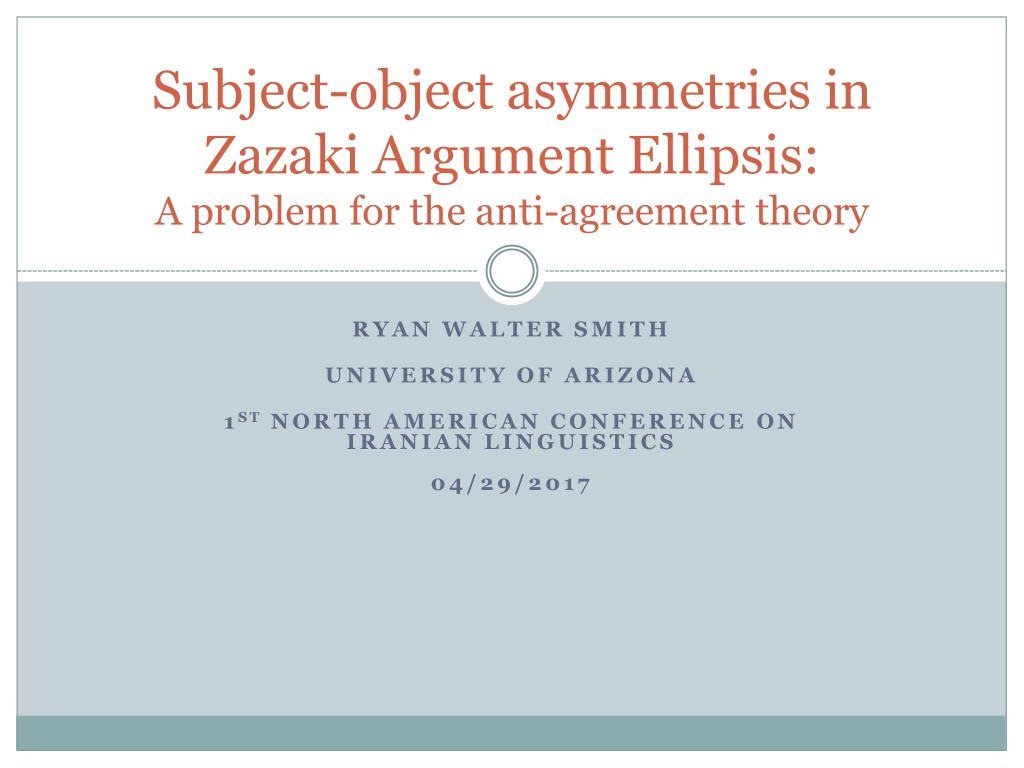
 undefined
undefined



















